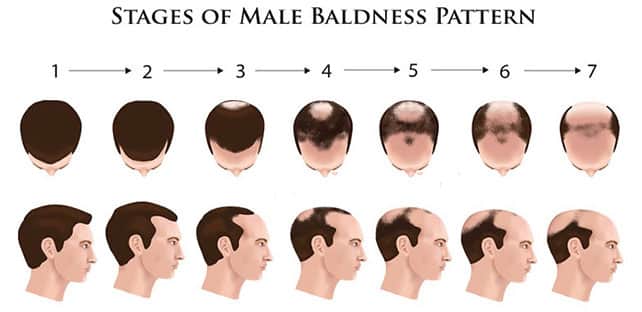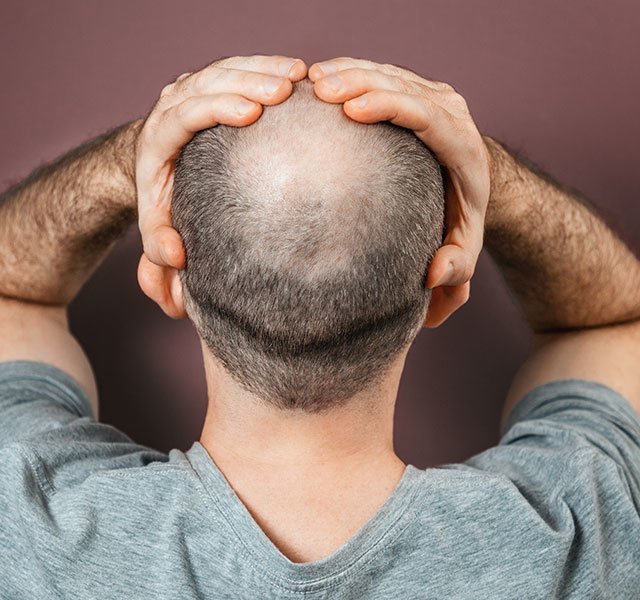Say goodbye to your hair fall woes with help from Hairrich Hair Restore Center, the finest hair clinic in Kurnool. We aim to provide quality services that reduce hair fall and boost hair growth.
Hair loss in a male is due to various reasons varying from genetics or hereditary, stress, change in eating habits, environmental factors, ageing or poor grooming such as hairstyle products, and so on. Hair loss in males may be genetic or non-genetic causes. Most of the hair loss in men around 80 to 90 % contributes to the interaction of genetic and hormones and called androgenetic alopecia or male pattern baldness. Male pattern hair loss is often considered as a relatively minor medical condition. Though in some men it may result in anxiety and depression, as it impacts self-image. Hence it is considered to be a common cosmetically and psychosocially distressing condition. The non-genetic causes such as ageing, underlying medical conditions, thyroid disorders, stress, smoking, severe dandruff , chemotherapy, environmental factors such as hard or chemically treated water, hairstyle products, or treatments.
Male pattern baldness is in which the thick hair in the androgen-sensitive scalp is turned into small thin hair. This is called miniaturization. The hair in the frontal area is lost earlier than the hair on the back of the scalp.
Male pattern hair loss is the most common type 80-90% of hair loss in men. Approximately 25 % of men suffer MPB process before 21 years of age, two-thirds of men (some degree of thinning) by the age of 35, and by the age of 50, approximately 80% of men have significantly thinning hair. Hair loss affects interpersonal relationships as it impacts self-image and may result in anxiety and depression.
Genetic susceptible or sensitive hair follicles to Dihydrotestosterone (DHT) begin to get affected by shortening the lifespan of each hair follicle. Thus the affected follicles stop producing healthy, thick, long, and cosmetically acceptable hair. Dihydrotestosterone (DHT) is a derivative of testosterone. Testosterone converts to DHT with the help of the enzyme Type II 5-alpha-reductase, which is present in the hair follicle’s oil glands. Moreover, the entire genetic process of male pattern hair loss is not clearly understood. It is known fact the DHT shrinks hair follicles, and if the DHT is suppressed by medication, hair follicles continue to grow. Hair follicles that are sensitive to DHT require a long period of time exposure for the affected follicles to complete the miniaturization process. Hence the early and right intervention during this process can slow or stop the male-pattern hair loss Although male pattern hair loss occurs due to genetic and hormonal interaction, other non-genetic factors such as stress, smoking, environmental factors, hairstyle products, and treatment contribute or accentuate to male pattern baldness.
Male pattern hair loss often begins to recede from the forehead in a line that resembles the letter’ M’ or receding hairline and thinning of crown, this pattern eventually progresses into leaving only a rim or “horseshoe” pattern of hair; and rarely progresses to complete baldness.
There are two other types of genetic hair loss in men, Diffuse Patterned Alopecia and Diffuse Unpatterned Alopecia, which constitute a significant challenge both in diagnosis and in the progression of male hair loss.
Their several scales to measure hair loss, but the most common use is Norwood-Hamilton Classification since 1941. It ranges from Stage I being the normal mature hairline with minimal temporal recession to Stage VII patients have extensive hair loss with only a rim of hair remaining in the back and sides of the scalp.

Treatment of male pattern hair loss depends upon the severity of hair loss, age, and their anxiety for the cosmetic demand.
This is the basic treatment for male pattern hair loss is finasteride and minoxidil . Finasteride blocks the hormone conversion of testosterone to dihydrotestosterone by inhibiting 5 alpha-reductase. DHT is responsible for hair loss by shortening the lifespan of each hair follicle. The topical application of Minoxidil increases blood flow to the scalp that helps to distribute nutrients to hair follicles, promoting hair growth in the affected area.
Other than finasteride and minoxidil medicine there are various procedures like mesotherapy, platelet-rich plasma (PRP) therapy , micro-needling (derma roller), low-level laser light therapy (LLLT) to treat hair loss. As early and right intervention during the affected growth hair cycle can slow or stop the male-pattern hair loss
Platelet-rich plasma (PRP) therapy for hair loss, involves the infiltration of concentrated growth factors, which are extracted from the blood of the patient and then transferred back to the scalp of the same patient.
Micro-needle therapy: During the micro-needling for hair loss treatment, thousands of tiny holes are created in the patient’s scalp with the help of a derma roller. These tiny holes result in the release of intrinsic growth factors at that site to stimulate hair growth. Micro-needling increases the blood circulation and helps for quick absorption of medicine such as minoxidil or finasteride or serum. Hence it works as a very effective supportive treatment.
Low-level laser light therapy (LLLT): Here the non-coherent light sources consisting of filtered lamps or light-emitting diodes (LED) are delivered to the hair to stimulate the hair follicles for faster growth. LLLT for hair loss emits the wavelength of infrared light is 630-670 nanometres. This treatment is approved by the US FDA for hair loss problems.
Mesotherapy: Here the growth peptides, stem cell extract, minoxidil, and various other growth factors are delivered locally to our hair with a special mechanical meso-gun.
Targeted Phototherapy with Lumera comb: This procedure helps in making the patients scalp dandruff free along with strengthening the hair roots.
However, all these interventional procedures along with medical treatment can provide excellent results in male-pattern hair loss provided the patient to follow regularly.
Hair transplantation is a procedure where the permanent hair follicles from the back and sides of the head (donor area) are relocated at the thinning or balding areas of the scalp (receipt area). This is a lifelong sustaining process because the hair follicles taken from the back of the head are genetically resistant to baldness, regardless of where they are relocated to. This is the most sought after procedure today to regain one’s lost hairline.

